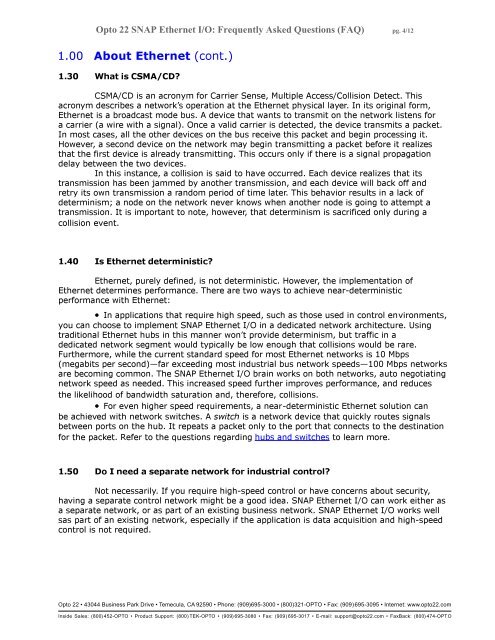pdf - Opto 22 SNAP Ethernet I/O Frequently Asked Questions (FAQ)
pdf - Opto 22 SNAP Ethernet I/O Frequently Asked Questions (FAQ)
pdf - Opto 22 SNAP Ethernet I/O Frequently Asked Questions (FAQ)
Create successful ePaper yourself
Turn your PDF publications into a flip-book with our unique Google optimized e-Paper software.
<strong>Opto</strong> <strong>22</strong> <strong>SNAP</strong> <strong>Ethernet</strong> I/O: <strong>Frequently</strong> <strong>Asked</strong> <strong>Questions</strong> (<strong>FAQ</strong>) pg. 4/12<br />
1.00 About <strong>Ethernet</strong> (cont.)<br />
1.30 What is CSMA/CD?<br />
CSMA/CD is an acronym for Carrier Sense, Multiple Access/Collision Detect. This<br />
acronym describes a network’s operation at the <strong>Ethernet</strong> physical layer. In its original form,<br />
<strong>Ethernet</strong> is a broadcast mode bus. A device that wants to transmit on the network listens for<br />
a carrier (a wire with a signal). Once a valid carrier is detected, the device transmits a packet.<br />
In most cases, all the other devices on the bus receive this packet and begin processing it.<br />
However, a second device on the network may begin transmitting a packet before it realizes<br />
that the first device is already transmitting. This occurs only if there is a signal propagation<br />
delay between the two devices.<br />
In this instance, a collision is said to have occurred. Each device realizes that its<br />
transmission has been jammed by another transmission, and each device will back off and<br />
retry its own transmission a random period of time later. This behavior results in a lack of<br />
determinism; a node on the network never knows when another node is going to attempt a<br />
transmission. It is important to note, however, that determinism is sacrificed only during a<br />
collision event.<br />
1.40 Is <strong>Ethernet</strong> deterministic?<br />
<strong>Ethernet</strong>, purely defined, is not deterministic. However, the implementation of<br />
<strong>Ethernet</strong> determines performance. There are two ways to achieve near-deterministic<br />
performance with <strong>Ethernet</strong>:<br />
• In applications that require high speed, such as those used in control environments,<br />
you can choose to implement <strong>SNAP</strong> <strong>Ethernet</strong> I/O in a dedicated network architecture. Using<br />
traditional <strong>Ethernet</strong> hubs in this manner won’t provide determinism, but traffic in a<br />
dedicated network segment would typically be low enough that collisions would be rare.<br />
Furthermore, while the current standard speed for most <strong>Ethernet</strong> networks is 10 Mbps<br />
(megabits per second)—far exceeding most industrial bus network speeds—100 Mbps networks<br />
are becoming common. The <strong>SNAP</strong> <strong>Ethernet</strong> I/O brain works on both networks, auto negotiating<br />
network speed as needed. This increased speed further improves performance, and reduces<br />
the likelihood of bandwidth saturation and, therefore, collisions.<br />
• For even higher speed requirements, a near-deterministic <strong>Ethernet</strong> solution can<br />
be achieved with network switches. A switch is a network device that quickly routes signals<br />
between ports on the hub. It repeats a packet only to the port that connects to the destination<br />
for the packet. Refer to the questions regarding hubs and switches to learn more.<br />
1.50 Do I need a separate network for industrial control?<br />
Not necessarily. If you require high-speed control or have concerns about security,<br />
having a separate control network might be a good idea. <strong>SNAP</strong> <strong>Ethernet</strong> I/O can work either as<br />
a separate network, or as part of an existing business network. <strong>SNAP</strong> <strong>Ethernet</strong> I/O works well<br />
sas part of an existing network, especially if the application is data acquisition and high-speed<br />
control is not required.<br />
<strong>Opto</strong> <strong>22</strong> 43044 Business Park Drive Temecula, CA 92590 Phone: (909)695-3000 (800)321-OPTO Fax: (909)695-3095 Internet : www.opto<strong>22</strong>.com<br />
Inside Sales: (800) 452-OPTO Product Support: (800) TEK-OPTO (909) 695-3080 Fax: (909) 695-3017 E-mail: support@opto<strong>22</strong>.com FaxBack: (800) 474-OPTO
















